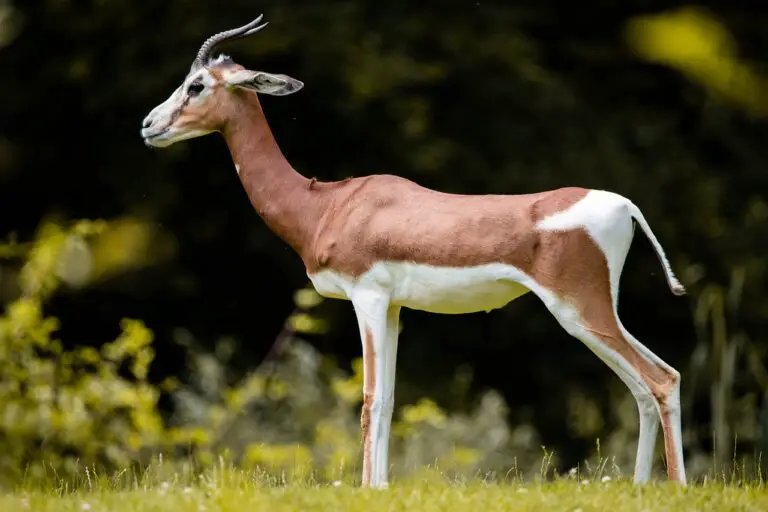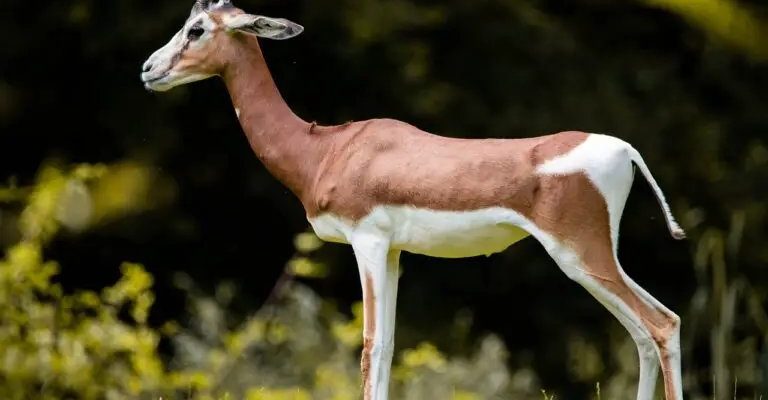
In this article, we’re diving into the world of animals similar to the antelope. I’ll share details about ten of them, helping you learn how to recognize them and appreciate their unique qualities. Think of this as your guide to spotting these fascinating creatures in the wild, and let’s discover how to tell them apart!
1. Gazelle
If there’s an animal that often gets confused with the antelope, it’s the gazelle. Honestly, they share a lot of similarities, both in appearance and behavior. Gazelles are known for their slender bodies and long, slender legs, just like antelopes. They’re incredibly fast, able to sprint at speeds of up to 60 miles per hour when chased by predators.
One way to spot a gazelle is by its distinct color patterns. Generally, they have a tan coat with white underbellies and unique facial markings. Unlike many antelopes, gazelles often have a more graceful appearance, especially when they leap—this is called “stotting.” You might notice they often seem to “show off” their speed when they sense danger.
When you compare them side by side with an antelope, gazelles are usually smaller and more delicate. They also prefer open grasslands and savannahs, which is why you might see them frolicking in similar habitats.
2. Impala
Next up is the impala, another relative of the antelope. Impalas have a lot in common with antelopes, but they also have their unique traits. For starters, impalas are known for their incredible agility. They can make high leaps and quick turns, which helps them evade predators.
You can tell an impala apart from an antelope by its unique facial markings and the characteristic black stripe running down its legs. The males are particularly stunning with their long, curved horns. Impalas are also more social creatures, often seen in large herds, which adds to their charm.
An interesting fact about impalas is that they can leap up to 10 feet high! This impressive skill helps them navigate the tricky terrain of their habitat, which includes woodlands and savannahs.
3. Springbok
If you’re looking for an animal that captures the spirit of the African savannah, the springbok is a great example. These creatures are known not just for their beauty but also for their energetic display called “pronking,” where they leap high into the air, showing off their strength and agility.
Springboks are slightly smaller than most antelopes, with a distinct white patch on their rear that fans out when they jump. This feature helps communicate with others in their group. Unlike many antelopes, springboks can thrive in arid deserts, finding ways to survive where water is scarce.
When distinguishing them from antelopes, pay attention to their unique leap and the way they carry themselves—it’s a blend of elegance and playfulness.
4. Elk
Elk might not be your first thought when you picture animals similar to antelopes, but they share a few traits! These large mammals are known for their impressive antlers and strong, muscular bodies. Unlike the slender build of most antelopes, elk are more robust.
In terms of habitat, elk typically inhabit forests and mountainous regions, which sets them apart from the open plains where many antelopes live. Their coats also vary from brown to a light tan, making them somewhat reminiscent of some larger antelope species.
One significant difference between elk and antelopes is their social structure. While antelopes tend to roam in smaller herds, elk can form large groups, especially during the mating season. If you spot a herd of big, majestic creatures in a forest, there’s a good chance they could be elk!
5. Nilgai
The nilgai, or blue bull, is a unique species found in India and parts of Nepal. This large antelope is easily recognizable by its bluish-gray coat and striking white markings. Males are particularly notable for their size and can weigh over 600 pounds!
One way to tell nilgai apart from other antelopes is their hefty build and the absence of the delicate features you might expect from a typical antelope. Unlike many of their relatives, nilgai prefer grasslands and scrub forests. Their unique coloration and robust shape set them apart in a crowd.
Although they may resemble antelope, nilgai tend to be more solitary or found in smaller groups. If you remember this, spotting a nilgai will be much easier on your next excursion!
6. Sitatunga
Now, let’s talk about the sitatunga, a fascinating swamp-dwelling antelope. These animals are incredible swimmers, unlike most of their relatives. With long, splayed hooves, they can easily navigate marshy areas and even dive underwater to escape predators.
You can identify a sitatunga by its shaggy, water-resistant fur and unique coloration, which ranges from brown to gray with white stripes. One cool thing about sitatungas is that males can often be larger and darker than females, giving them a more pronounced appearance.
Their adaptations for wet habitats mean they’re not as commonly found in open savannahs. Instead, keep an eye out for them in wetlands, where they blend in beautifully with their surroundings.
7. Bongo
The bongo is a striking antelope known for its vivid orange-red coat and bold white stripes. These stunning patterns make bongos one of the most beautiful antelopes in the world. They are primarily found in dense tropical forests, which sets them apart from many other antelope species.
Unlike the more open-habitat creatures we’ve discussed, bongos are shy and elusive. You might spot them at dusk or dawn, as they prefer to be active in cooler temperatures. They’re also quite agile, capable of navigating tricky forest terrain despite their size.
Their long spiraled horns can grow up to three feet, making them an impressive sight when you catch a glimpse among the trees. Next time you’re exploring a jungle-like setting, keep an eye out for these stunning creatures!
8. Waterbuck
The waterbuck is another antelope that thrives near water sources like rivers and lakes. You can identify a waterbuck by its shaggy fur and distinctive white ring around its rear. These features make them stand out in their natural habitat.
Waterbucks’ adaptation to wetlands allows them to graze on the abundant grass found near these areas, and they have a unique ability to escape predators by jumping into the water. Their large size and robust build differentiate them from smaller antelope species.
You’ll often find them in herds, which adds a social element to their behavior. If you ever encounter a group of large, shaggy animals near a water source, you’re likely looking at waterbucks!
9. Kudu
When it comes to beauty and grace, the kudu deserves a mention. With long, twisted horns and a more slender body, kudus are stunning animals that often roam in woodlands and savannahs. Their striking coat, which has vertical white stripes on a gray background, helps them blend in with their forested habitats.
Kudus are also known for their impressive ability to leap and navigate through dense brush, making them quite elusive. You might spot them in smaller groups or sometimes as solitary individuals, which adds to their mysterious nature.
One way to tell them apart from other antelopes is by their long, spiraled horns, which are more prominent in males. If you’re ever on a safari and catch a glimpse of these striking creatures, take a moment to appreciate their beauty!
10. Gemsbok
Finally, let’s discuss the gemsbok, a striking antelope with a bold appearance. They are easily recognizable due to their long, straight horns and striking facial markings. Often found in arid regions, gemsboks are well-adapted to survive in harsh environments.
You might spot gemsboks standing tall in the heat, their unique coloration providing excellent camouflage in the desert landscape. While they share some physical traits with antelopes, their robust build and the distinctive way they carry their horns make them stand out.
One interesting aspect of gemsbok behavior is their ability to go for long periods without drinking water, relying on moisture from the plants they consume. This makes them fascinating creatures to observe in their natural habitat.
In conclusion, recognizing animals similar to the antelope is all about paying attention to details. Each species we’ve discussed has its unique characteristics that set it apart, from their size and habitat preferences to their distinctive markings and behaviors. So the next time you’re on a wildlife adventure, if you spot an antelope or one of its relatives, you’ll be well-equipped to tell them apart. Happy wildlife watching!

